Abstract
Exogenous superoxide dismutase, catalase and scavengers of the hydroxyl radical protect pancreatic-islet cells against the toxic actions of alloxan in vitro [Grankvist et al. (1979) Biochem. J. 182, 17--25]. To test whether the extraordinary sensitivity of islet cells to alloxan is due to a deficiency of endogenous enzymes protecting against oxygen-reduction products, we assayed CuZn-superoxide dismutase, Mn-superoxide dismutase, catalase and glutathione peroxidase in mouse islets and other tissues. To correct for any blood contamination, haemoglobin was also measured in the tissue samples. Pancreatic islets were found to belong to tissues with relatively little activity of the protective enzymes. However, the deviation from other tissues in this respect is probably not large enough to explain the especially great susceptibility of islet cells to alloxan.
Full text
PDF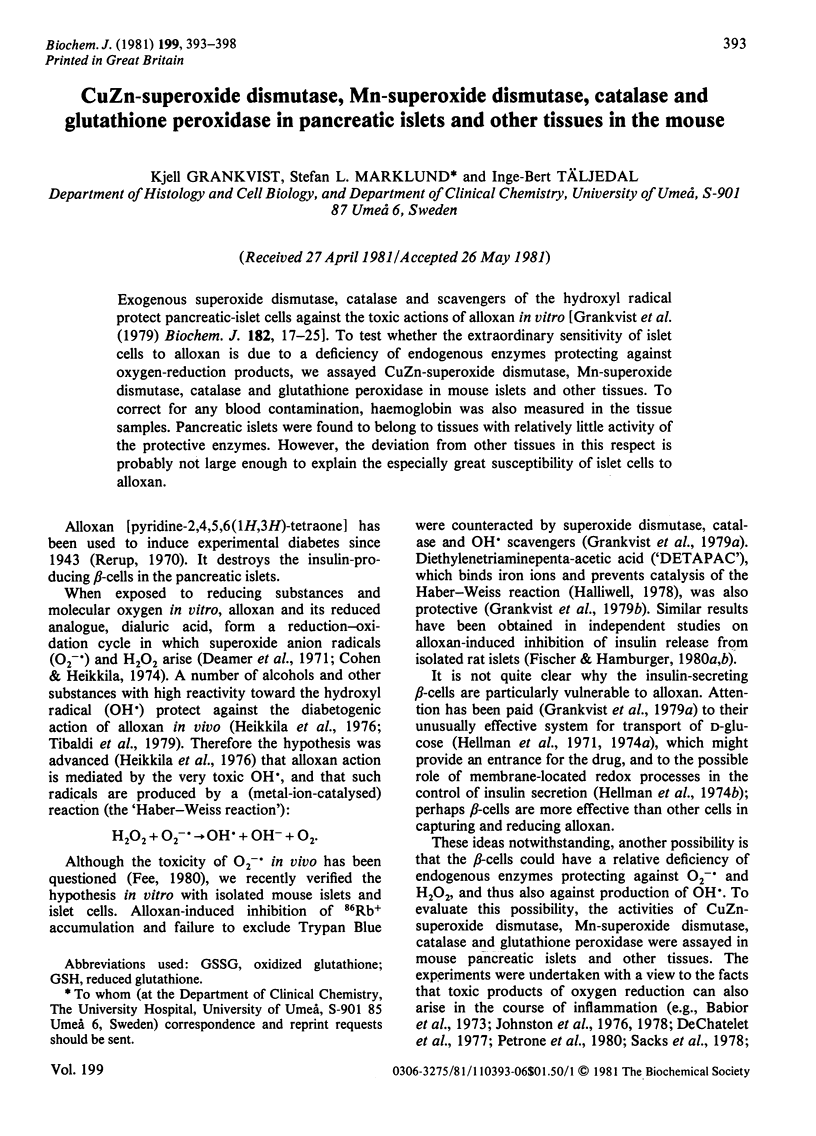
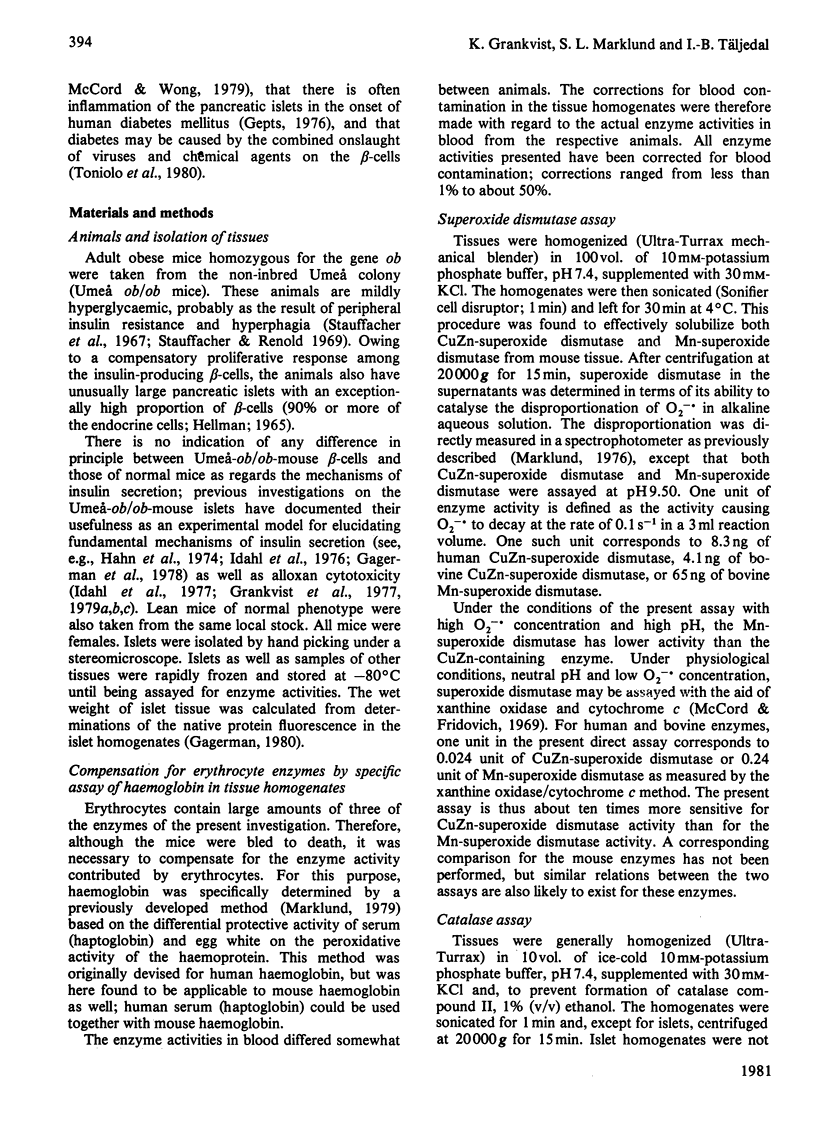
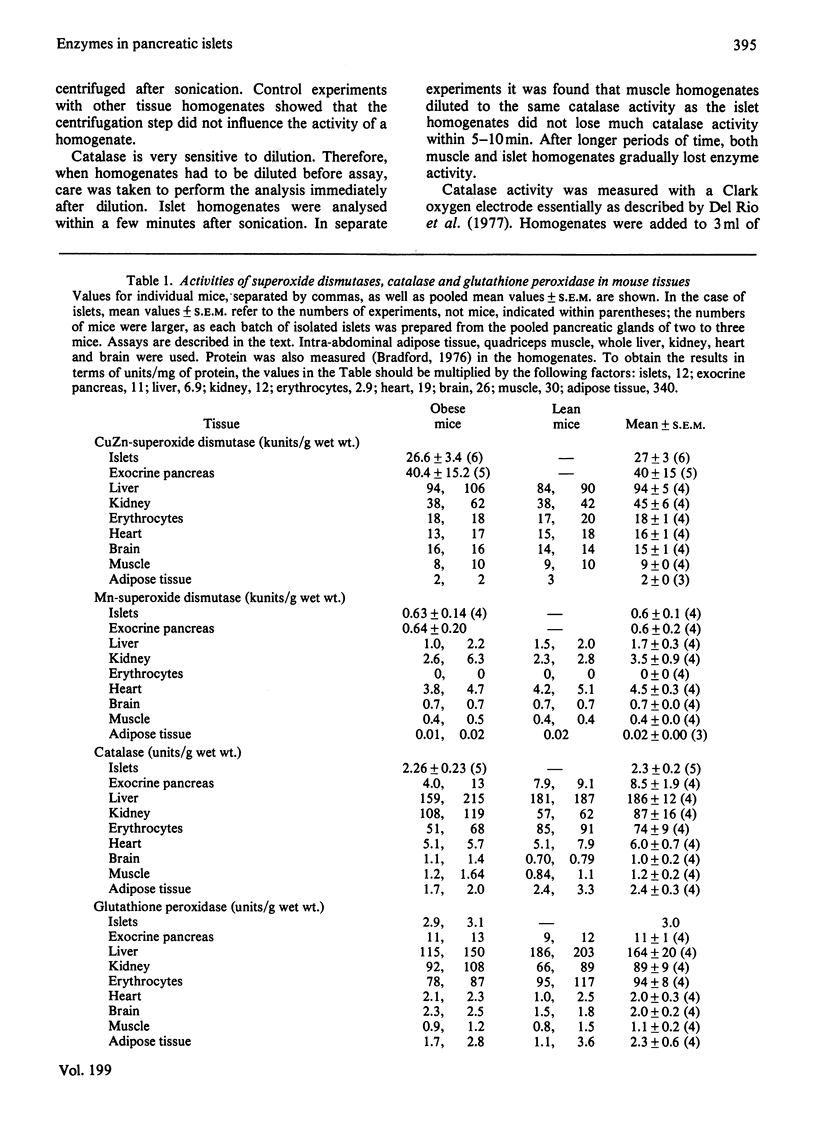
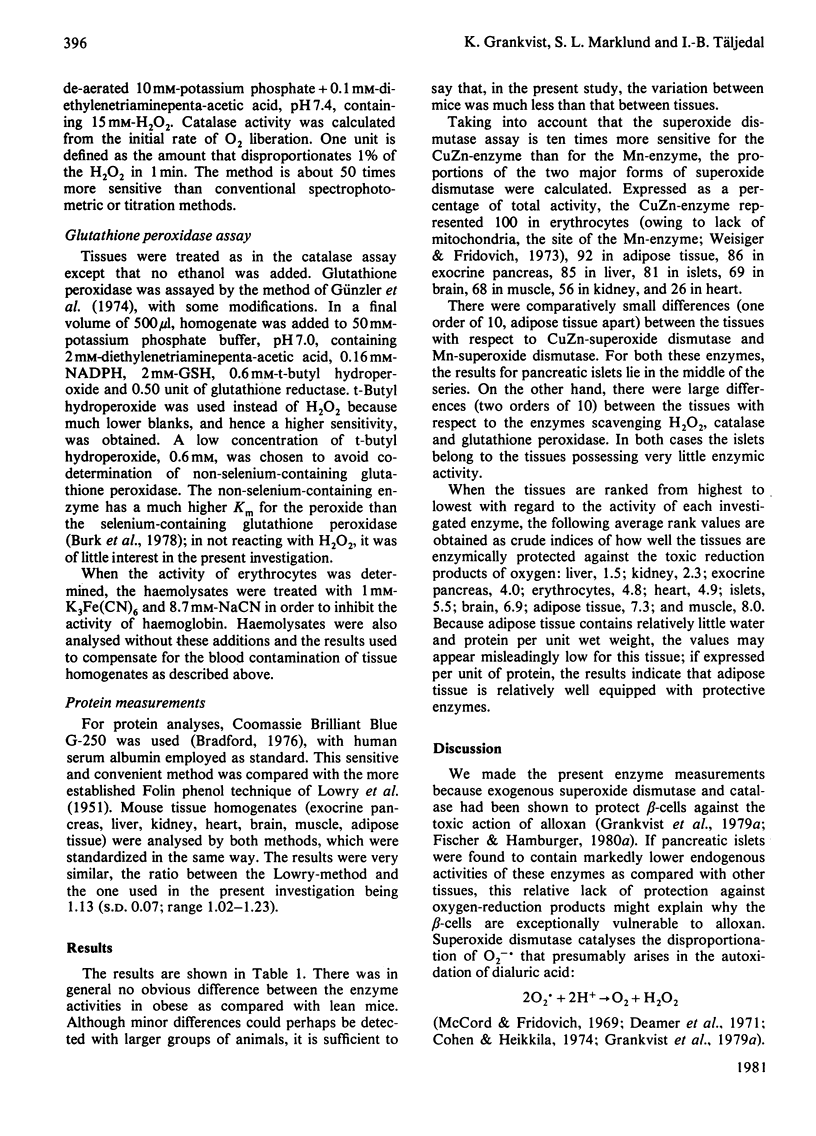
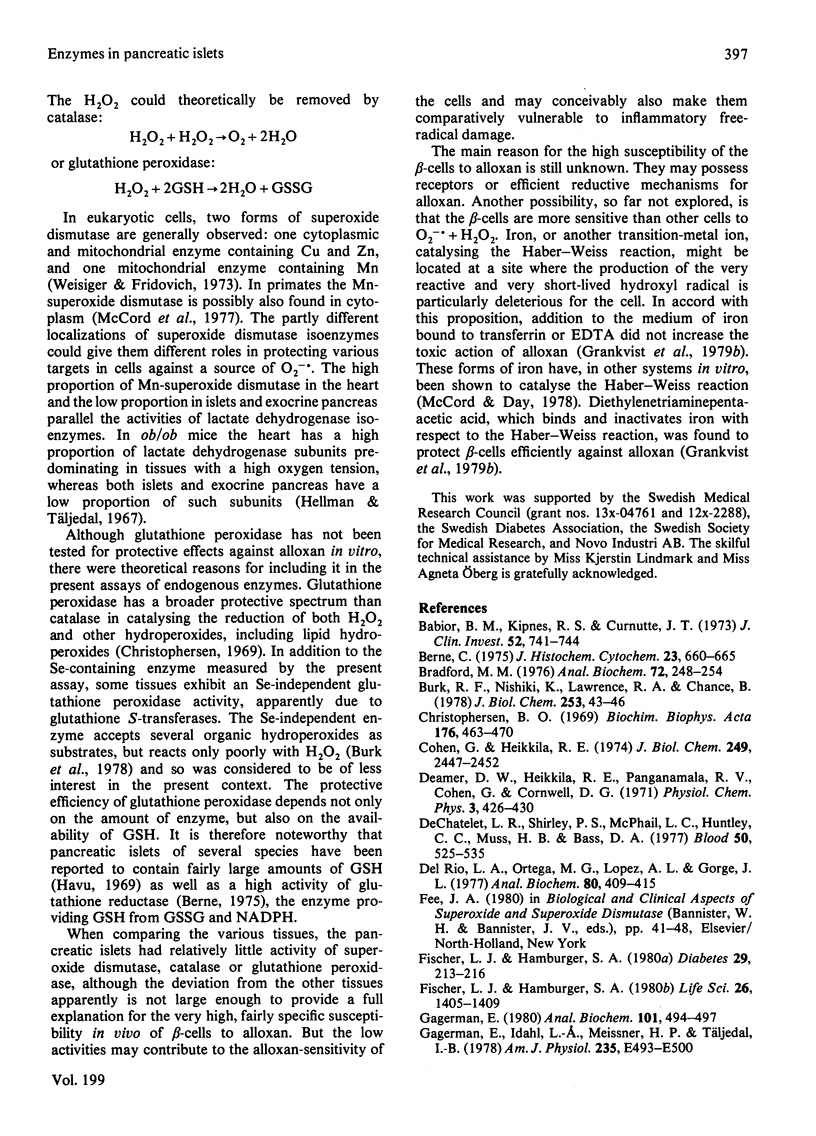
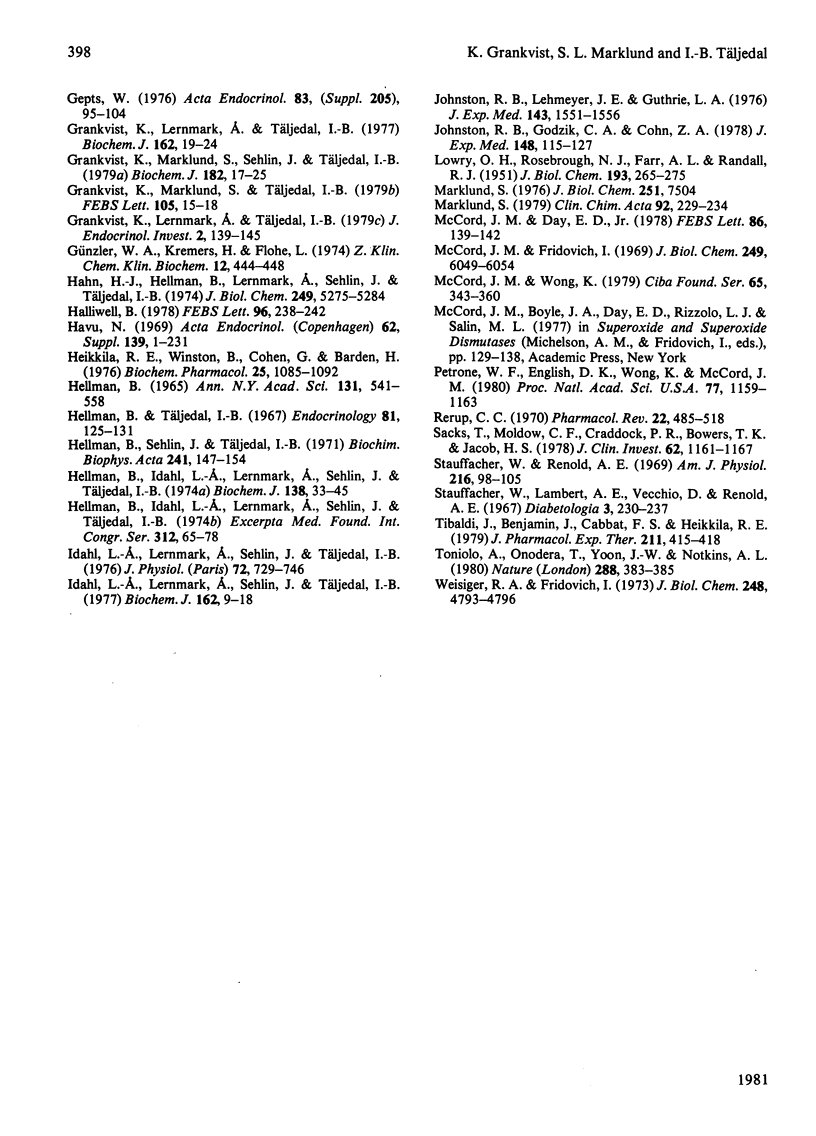
Selected References
These references are in PubMed. This may not be the complete list of references from this article.
- Babior B. M., Kipnes R. S., Curnutte J. T. Biological defense mechanisms. The production by leukocytes of superoxide, a potential bactericidal agent. J Clin Invest. 1973 Mar;52(3):741–744. doi: 10.1172/JCI107236. [DOI] [PMC free article] [PubMed] [Google Scholar]
- Berne C. Nicotinamide adenine dinucleotide phosphate-converting enzymes and adenosine triphosphate citrate lyase in some tissues and organs of New Zealand obese mice with special reference to the enzyme pattern of the pancreatic islets. J Histochem Cytochem. 1975 Sep;23(9):660–665. doi: 10.1177/23.9.240882. [DOI] [PubMed] [Google Scholar]
- Bradford M. M. A rapid and sensitive method for the quantitation of microgram quantities of protein utilizing the principle of protein-dye binding. Anal Biochem. 1976 May 7;72:248–254. doi: 10.1016/0003-2697(76)90527-3. [DOI] [PubMed] [Google Scholar]
- Burk R. F., Nishiki K., Lawrence R. A., Chance B. Peroxide removal by selenium-dependent and selenium-independent glutathione peroxidases in hemoglobin-free perfused rat liver. J Biol Chem. 1978 Jan 10;253(1):43–46. [PubMed] [Google Scholar]
- Christophersen B. O. Reduction of linolenic acid hydroperoxide by a glutathione peroxidase. Biochim Biophys Acta. 1969 Apr 29;176(3):463–470. doi: 10.1016/0005-2760(69)90213-6. [DOI] [PubMed] [Google Scholar]
- Cohen G., Heikkila R. E. The generation of hydrogen peroxide, superoxide radical, and hydroxyl radical by 6-hydroxydopamine, dialuric acid, and related cytotoxic agents. J Biol Chem. 1974 Apr 25;249(8):2447–2452. [PubMed] [Google Scholar]
- DeChatelet L. R., Shirley P. S., McPhail L. C., Huntley C. C., Muss H. B., Bass D. A. Oxidative metabolism of the human eosinophil. Blood. 1977 Sep;50(3):525–535. [PubMed] [Google Scholar]
- Del Río L. A., Ortega M. G., López A. L., Gorgé J. L. A more sensitive modification of the catalase assay with the Clark oxygen electrode. Application to the kinetic study of the pea leaf enzyme. Anal Biochem. 1977 Jun;80(2):409–415. doi: 10.1016/0003-2697(77)90662-5. [DOI] [PubMed] [Google Scholar]
- Fischer L. J., Hamburger S. A. Dimethylurea: a radical scavenger that protects isolated pancreatic islets from the effects of alloxan and dihydroxyfumarate exposure. Life Sci. 1980 Apr 28;26(17):1405–1409. doi: 10.1016/0024-3205(80)90043-0. [DOI] [PubMed] [Google Scholar]
- Fischer L. J., Hamburger S. A. Inhibition of alloxan action in isolated pancreatic islets by superoxide dismutase, catalase, and a metal chelator. Diabetes. 1980 Mar;29(3):213–216. doi: 10.2337/diab.29.3.213. [DOI] [PubMed] [Google Scholar]
- Gagerman E. Determination of pancreatic islet mass by measurement of native protein fluorescence. Anal Biochem. 1980 Jan 15;101(2):494–497. doi: 10.1016/0003-2697(80)90219-5. [DOI] [PubMed] [Google Scholar]
- Gagerman E., Idahl L. A., Meissner H. P., Täljedal I. B. Insulin release, cGMP, cAMP, and membrane potential in acetylcholine-stimulated islets. Am J Physiol. 1978 Nov;235(5):E493–E500. doi: 10.1152/ajpendo.1978.235.5.E493. [DOI] [PubMed] [Google Scholar]
- Grankvist K., Lernmark A., Täljedal I. B. Alloxan cytotoxicity in vitro. Microscope photometric analyses of Trypan Blue uptake by pancreatic islet cells in suspension. Biochem J. 1977 Jan 15;162(1):19–24. doi: 10.1042/bj1620019. [DOI] [PMC free article] [PubMed] [Google Scholar]
- Grankvist K., Lernmark A., Täljedal I. B. Trypan Blue as a marker of plasma membrane permeability in alloxan-treated mouse islet cells. J Endocrinol Invest. 1979 Apr-Jun;2(2):139–145. doi: 10.1007/BF03349305. [DOI] [PubMed] [Google Scholar]
- Grankvist K., Marklund S., Sehlin J., Täljedal I. B. Superoxide dismutase, catalase and scavengers of hydroxyl radical protect against the toxic action of alloxan on pancreatic islet cells in vitro. Biochem J. 1979 Jul 15;182(1):17–25. doi: 10.1042/bj1820017. [DOI] [PMC free article] [PubMed] [Google Scholar]
- Grankvist K., Marklund S., Täljedal I. B. Influence of trace metals on alloxan cytotoxicity in pancreatic islets. FEBS Lett. 1979 Sep 1;105(1):15–18. doi: 10.1016/0014-5793(79)80877-7. [DOI] [PubMed] [Google Scholar]
- Günzler W. A., Kremers H., Flohé L. An improved coupled test procedure for glutathione peroxidase (EC 1-11-1-9-) in blood. Z Klin Chem Klin Biochem. 1974 Oct;12(10):444–448. doi: 10.1515/cclm.1974.12.10.444. [DOI] [PubMed] [Google Scholar]
- Hahn H. J., Hellman B., Lernmark A., Sehlin J., Täljedal I. B. The pancreatic beta-cell recognition of insulin secretogogues. Influence of neuraminidase treatment on the release of insulin and the islet content of insulin, sialic acid, and cyclic adenosine 3':5'-monophosphate. J Biol Chem. 1974 Aug 25;249(16):5275–5284. [PubMed] [Google Scholar]
- Halliwell B. Superoxide-dependent formation of hydroxyl radicals in the presence of iron salts. Its role in degradation of hyaluronic acid by a superoxide-generating system. FEBS Lett. 1978 Dec 15;96(2):238–242. doi: 10.1016/0014-5793(78)80409-8. [DOI] [PubMed] [Google Scholar]
- Heikkila R. E., Winston B., Cohen G. Alloxan-induced diabetes-evidence for hydroxyl radical as a cytotoxic intermediate. Biochem Pharmacol. 1976 May 1;25(9):1085–1092. doi: 10.1016/0006-2952(76)90502-5. [DOI] [PubMed] [Google Scholar]
- Hellman B., Idahl L. A., Lernmark A., Sehlin J., Täljedal I. B. The pancreatic beta-cell recognition of insulin secretagogues. Effects of calcium and sodium on glucose metabolism and insulin release. Biochem J. 1974 Jan;138(1):33–45. doi: 10.1042/bj1380033. [DOI] [PMC free article] [PubMed] [Google Scholar]
- Hellman B., Sehlin J., Täljedal I. B. Evidence for mediated transport of glucose in mammalian pancreatic -cells. Biochim Biophys Acta. 1971 Jul 6;241(1):147–154. doi: 10.1016/0005-2736(71)90312-9. [DOI] [PubMed] [Google Scholar]
- Hellman B. Studies in obese-hyperglycemic mice. Ann N Y Acad Sci. 1965 Oct 8;131(1):541–558. doi: 10.1111/j.1749-6632.1965.tb34819.x. [DOI] [PubMed] [Google Scholar]
- Hellman B., Täljedal I. B. Quantitative studies on isolated pancreatic islets of mammals. Activity and heterogeneity of lactate dehydrogenase in obese-hyporglycemic mice. Endocrinology. 1967 Jul;81(1):125–131. doi: 10.1210/endo-81-1-125. [DOI] [PubMed] [Google Scholar]
- Idahl L. A., Lernmark A., Sehlin J., Täljedal I. B. Alloxan cytotoxicity in vitro. Inhibition of rubidium ion pumping in pancreatic beta-cells. Biochem J. 1977 Jan 15;162(1):9–18. doi: 10.1042/bj1620009. [DOI] [PMC free article] [PubMed] [Google Scholar]
- Idahl L. A., Lernmark A., Sehlin J., Täljedal I. B. Studies on the function of pancreatic islet cell membranes. J Physiol (Paris) 1976 Nov;72(6):729–746. [PubMed] [Google Scholar]
- Johnston R. B., Jr, Godzik C. A., Cohn Z. A. Increased superoxide anion production by immunologically activated and chemically elicited macrophages. J Exp Med. 1978 Jul 1;148(1):115–127. doi: 10.1084/jem.148.1.115. [DOI] [PMC free article] [PubMed] [Google Scholar]
- Johnston R. B., Jr, Lehmeyer J. E., Guthrie L. A. Generation of superoxide anion and chemiluminescence by human monocytes during phagocytosis and on contact with surface-bound immunoglobulin G. J Exp Med. 1976 Jun 1;143(6):1551–1556. doi: 10.1084/jem.143.6.1551. [DOI] [PMC free article] [PubMed] [Google Scholar]
- Marklund S. A simple specific method for the determination of the hemoglobin content of tissue homogenates. Clin Chim Acta. 1979 Mar 1;92(2):229–234. doi: 10.1016/0009-8981(79)90117-7. [DOI] [PubMed] [Google Scholar]
- Marklund S. Spectrophotometric study of spontaneous disproportionation of superoxide anion radical and sensitive direct assay for superoxide dismutase. J Biol Chem. 1976 Dec 10;251(23):7504–7507. [PubMed] [Google Scholar]
- McCord J. M., Day E. D., Jr Superoxide-dependent production of hydroxyl radical catalyzed by iron-EDTA complex. FEBS Lett. 1978 Feb 1;86(1):139–142. doi: 10.1016/0014-5793(78)80116-1. [DOI] [PubMed] [Google Scholar]
- McCord J. M., Fridovich I. Superoxide dismutase. An enzymic function for erythrocuprein (hemocuprein). J Biol Chem. 1969 Nov 25;244(22):6049–6055. [PubMed] [Google Scholar]
- Petrone W. F., English D. K., Wong K., McCord J. M. Free radicals and inflammation: superoxide-dependent activation of a neutrophil chemotactic factor in plasma. Proc Natl Acad Sci U S A. 1980 Feb;77(2):1159–1163. doi: 10.1073/pnas.77.2.1159. [DOI] [PMC free article] [PubMed] [Google Scholar]
- Rerup C. C. Drugs producing diabetes through damage of the insulin secreting cells. Pharmacol Rev. 1970 Dec;22(4):485–518. [PubMed] [Google Scholar]
- Sacks T., Moldow C. F., Craddock P. R., Bowers T. K., Jacob H. S. Oxygen radicals mediate endothelial cell damage by complement-stimulated granulocytes. An in vitro model of immune vascular damage. J Clin Invest. 1978 May;61(5):1161–1167. doi: 10.1172/JCI109031. [DOI] [PMC free article] [PubMed] [Google Scholar]
- Stauffacher W., Lambert A. E., Vecchio D., Renold A. E. Measurements of insulin activities in pancreas and serum of mice with spontaneous ("Obese" and "New Zealand Obese") and induced (Goldthioglucose) obesity and hyperglycemia, with considerations on the pathogenesis of the spontaneous syndrome. Diabetologia. 1967 Apr;3(2):230–237. doi: 10.1007/BF01222200. [DOI] [PubMed] [Google Scholar]
- Stauffacher W., Renold A. E. Effect of insulin in vivo on diaphragm and adipose tissue of obese mice. Am J Physiol. 1969 Jan;216(1):98–105. doi: 10.1152/ajplegacy.1969.216.1.98. [DOI] [PubMed] [Google Scholar]
- Tibaldi J., Benjamin J., Cabbat F. S., Heikkila R. E. Protection against alloxan-induced diabetes by various urea derivatives: relationship between protective effects and reactivity with the hydroxyl radical. J Pharmacol Exp Ther. 1979 Nov;211(2):415–418. [PubMed] [Google Scholar]
- Toniolo A., Onodera T., Yoon J. W., Notkins A. L. Induction of diabetes by cumulative environmental insults from viruses and chemicals. Nature. 1980 Nov 27;288(5789):383–385. doi: 10.1038/288383a0. [DOI] [PubMed] [Google Scholar]
- Weisiger R. A., Fridovich I. Mitochondrial superoxide simutase. Site of synthesis and intramitochondrial localization. J Biol Chem. 1973 Jul 10;248(13):4793–4796. [PubMed] [Google Scholar]


